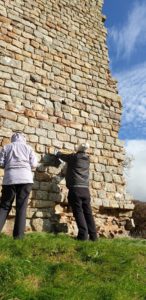Newcastle University, National Lottery Heritage Fund, Local Community and Volunteers.
October 2017 – December 2021
Multi-Stakeholder collaboration involving Newcastle University, Hadrian’s Wall World Heritage Site (WHS) stakeholders, local communities, volunteers and National Lottery Heritage Fund. An ambitious community collaboration that engages local communities and volunteers in the vital task of securing the heritage for future generations.
Hadrian’s Wall, part of the UNESCO transnational Frontiers of the Roman Empire World Heritage Site (WHS), is one of the most famous ancient monuments in the world, yet many aspects of it are still poorly understood and some portions of it are in poor and deteriorating condition. By building a community-based network, guided and trained by professionals, the project aims to foster local engagement and social investment in heritage landscapes.
Funded by the National Lottery Heritage Fund, the collaboration brought together key stakeholders and communities to deliver a range of exciting events for local communities along the entire length of Hadrian’s Wall and the Cumbrian coast.
The project provides local communities with the knowledge and skills to understand how the Wall has literally and metaphorically provided the building blocks for present-day communities, by exploring the way in which the Wall’s building fabric has been reused in the centuries following Roman rule of Britain. The project also communicates and engages the need to actively engage in heritage conservation, building bridges between the monument, local communities, and various stakeholder organisations in the WHS.
A coordinated and informed network of experts, and engaged and empowered local communities and volunteers confident in securing the heritage for future generations;
a number of sites left in a physically improved condition;
contributions to exhibitions at the Great North Museum: Hancock and Tullie House Museum
There is lots of passion and desire by individuals and communities to play an active role in their heritage.
Rewarding engagement for volunteers requires staffing dedicated to volunteer and community liaison and communications, alongside complementary expert staff.
Further information can be found at https://wallcap.ncl.ac.uk/project-aims-overview/

Bringing together senior members of staff from public and non-government bodies to work collaboratively on strategic matters for the historic environment sector.